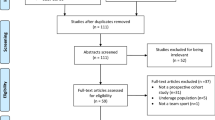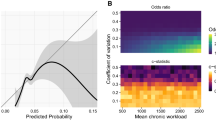Abstract
Injuries occur when an athlete performs a greater amount of activity than what their body can withstand. To maximize the positive effects of training while avoiding injuries, athletes and coaches need to determine safe activity levels. The International Olympic Committee has recommended using the acute:chronic workload ratio (ACWR) to monitor injury risk and has provided thresholds to minimize risk when designing training programs. However, there are several limitations to the ACWR and how it has been analyzed which impact the validity of current recommendations and should discourage its use. This review aims to discuss previously published and novel challenges with the ACWR, and strategies to improve current analytical methods. In the first part of this review, we discuss challenges inherent to the ACWR. We explain why using a ratio to represent changes in activity may not always be appropriate. We also show that using exponentially weighted moving averages to calculate the ACWR results in an initial load problem, and discuss their inapplicability to sports where athletes taper their activity. In the second part, we discuss challenges with how the ACWR has been implemented. We cover problems with discretization, sparse data, bias in injured athletes, unmeasured and time-varying confounding, and application to subsequent injuries. In the third part, conditional on well-conceived study design, we discuss alternative causal-inference based analytical strategies that may avoid major flaws in studies on changes in activity and injury occurrence.

(reproduced from Gabbett [8], with permission)

(reproduced from Menaspà [25], with permission)



Similar content being viewed by others
References
Finch CF, Owen N. Injury prevention and the promotion of physical activity: what is the nexus? J Sci Med Sport. 2001;4:77–87.
Wiesinger HP, Kösters A, Müller E, Seynnes OR. Effects of increased loading on in vivo tendon properties: a systematic review. Med Sci Sports Exerc. 2015;47:1885–95.
Quinn E. Sports injury prevention using the 10 percent rule. In: Verywell Fit. 2019. https://www.verywellfit.com/sports-injury-prevention-using-the-10-percent-rule-3120767. Accessed 4 Nov 2019.
Burfoot A. The 10 Laws of Injury Prevention. In: Runner’s World. 2010. https://www.runnersworld.com/health-injuries/a20819497/the-10-laws-of-injury-prevention/. Accessed 4 Nov 2019.
Fitzgerald J. Forget the 10% rule: how to increase mileage safely. In: Strength running. 2010. https://strengthrunning.com/2010/06/how-to-increase-mileage/. Accessed 4 Nov 2019.
Hulin BT, Gabbett TJ, Blanch P, Chapman P, Bailey D, Orchard JW. Spikes in acute workload are associated with increased injury risk in elite cricket fast bowlers. Br J Sports Med. 2014;48:708–12.
Carey DL, Blanch P, Ong K-L, Crossley KM, Crow J, Morris ME. Training loads and injury risk in Australian football—differing acute: chronic workload ratios influence match injury risk. Br J Sports Med. 2017;51:1215–20.
Gabbett TJ. The training—injury prevention paradox: should athletes be training smarter and harder? Br J Sports Med. 2016;50:273–80.
Hulin BT, Gabbett TJ, Lawson DW, Caputi P, Sampson JA. The acute:chronic workload ratio predicts injury: high chronic workload may decrease injury risk in elite rugby league players. Br J Sports Med. 2016;50:231–6.
Murray NB, Gabbett TJ, Townshend AD, Hulin BT, McLellan CP. Individual and combined effects of acute and chronic running loads on injury risk in elite Australian footballers. Scand J Med Sci Sports. 2017;27:990–8.
Malone S, Owen A, Newton M, Mendes B, Collins KD, Gabbett TJ. The acute:chonic workload ratio in relation to injury risk in professional soccer. J Sci Med Sport. 2017;20:561–5.
Bowen L, Gross AS, Gimpel M, Li F-X. Accumulated workloads and the acute:chronic workload ratio relate to injury risk in elite youth football players. Br J Sports Med. 2017;51:452–9.
Blanch P, Gabbett TJ. Has the athlete trained enough to return to play safely? The acute:chronic workload ratio permits clinicians to quantify a player’s risk of subsequent injury. Br J Sports Med. 2016;50:471–5.
Soligard T, Schwellnus M, Alonso J-M, Bahr R, Clarsen B, Dijkstra HP, et al. How much is too much? (Part 1) International Olympic Committee consensus statement on load in sport and risk of injury. Br J Sports Med. 2016;50:1030–41.
Buchheit M. Applying the acute:chronic workload ratio in elite football: worth the effort? Br J Sports Med. 2017;51:1325–7.
Impellizzeri FM, Marcora SM, Coutts AJ. Internal and external training load: 15 years on. Int J Sports Physiol Perform. 2019;14:270–3.
Impellizzeri FM, Wookcock S, McCall A, Ward P, Coutts AJ. The acute-chronic workload ratio-injury figure and its ‘sweet spot’ are flawed. SportRxiv 2019; https://osf.io/gs8yu.
Windt J, Gabbett TJ. Is it all for naught? What does mathematical coupling mean for acute:chronic workload ratios? Br J Sports Med. 2018;bjsports-2017-098925.
Lolli L, Batterham AM, Hawkins R, Kelly DM, Strudwick AJ, Thorpe R, et al. Mathematical coupling causes spurious correlation within the conventional acute-to-chronic workload ratio calculations. Br J Sports Med. 2017;bjsports-2017-098110.
Malisoux L, Frisch A, Urhausen A, Seil R, Theisen D. Monitoring of sport participation and injury risk in young athletes. J Sci Med Sport. 2013;16:504–8.
Curran-Everett D. Explorations in statistics: the analysis of ratios and normalized data. Adv Physiol Educ. 2013;37:213–9.
Atkinson G, Batterham A. The use of ratios and percentage changes in sports medicine: time for a rethink?·. Int J Sports Med. 2012;33:505–6.
Lolli L, Batterham AM, Hawkins R, Kelly DM, Strudwick AJ, Thorpe RT, et al. The acute-to-chronic workload ratio: an inaccurate scaling index for an unnecessary normalisation process? Br J Sports Med. 2018;bjsports-2017-098884.
Hawley JA. Adaptations of skeletal muscle to prolonged, intense endurance training. Clin Exp Pharmacol Physiol. 2002;29:218–22.
Menaspà P. Are rolling averages a good way to assess training load for injury prevention? Br J Sports Med. 2017;51:618–9.
Williams S, West S, Cross MJ, Stokes KA. Better way to determine the acute:chronic workload ratio? Br J Sports Med. 2017;51:209–10.
Murray NB, Gabbett TJ, Townshend AD, Blanch P. Calculating acute:chronic workload ratios using exponentially weighted moving averages provides a more sensitive indicator of injury likelihood than rolling averages. Br J Sports Med. 2017;51:749–54.
Thomas L, Busso T. A theoretical study of taper characteristics to optimize performance. Med Sci Sports Exerc. 2005;37:1615.
Mujika I, Padilla S. Scientific bases for precompetition tapering strategies. Med Sci Sports Exerc. 2003;35:1182.
Dugan SA, Frontera WR. Muscle fatigue and muscle injury. Phys Med Rehabil Clin N Am. 2000;11:385–403.
Liu H, Hussain F, Tan CL, Dash M. Discretization: an enabling technique. Data Min Knowl Discov. 2002;6:393–423.
Bennette C, Vickers A. Against quantiles: categorization of continuous variables in epidemiologic research, and its discontents. BMC Med Res Methodol. 2012;12:21.
Malone S, Owen A, Mendes B, Hughes B, Collins K, Gabbett TJ. High-speed running and sprinting as an injury risk factor in soccer: can well-developed physical qualities reduce the risk? J Sci Med Sport. 2018;21:257–62.
Colby MJ, Dawson B, Peeling P, Heasman J, Rogalski B, Drew MK, et al. Multivariate modelling of subjective and objective monitoring data improve the detection of non-contact injury risk in elite Australian footballers. J Sci Med Sport. 2017;20:1068–74.
Carey DL, Crossley KM, Whiteley R, Mosler A, Ong K-L, Crow J, et al. Modeling training loads and injuries: the dangers of discretization. Med Sci Sports Exerc. 2018;50:2267–76.
Nielsen RO, Bertelsen ML, Ramskov D, Møller M, Hulme A, Theisen D, et al. Time-to-event analysis for sports injury research part 2: time-varying outcomes. Br J Sports Med. 2019;53:70–8.
Riley RD, Snell KI, Ensor J, Burke DL, Harrell FE Jr, Moons KG, et al. Minimum sample size for developing a multivariable prediction model: Part II—binary and time-to-event outcomes. Stat Med. 2019;38:1276–96.
Moons KGM, Altman DG, Reitsma JB, Ioannidis JPA, Macaskill P, Steyerberg EW, et al. Transparent reporting of a multivariable prediction model for individual prognosis or diagnosis (TRIPOD): explanation and elaboration. Ann Intern Med. 2015;162:W1.
Schulz KF, Altman DG, Moher D, the CONSORT Group. CONSORT. Statement: updated guidelines for reporting parallel group randomised trials. BMC Med. 2010;2010(8):18.
von Elm E, Altman DG, Egger M, Pocock SJ, Gøtzsche PC, Vandenbroucke JP. Strengthening the reporting of observational studies in epidemiology (STROBE) statement: guidelines for reporting observational studies. BMJ. 2007;335:806–8.
Greenland S, Mansournia MA, Altman DG. Sparse data bias: a problem hiding in plain sight. BMJ. 2016;352:i1981.
Williamson DS, Bangdiwala SI, Marshall SW, Waller AE. Repeated measures analysis of binary outcomes: applications to injury research. Accid Anal Prev. 1996;28:571–9.
Cook JL, Docking SI. “Rehabilitation will increase the ‘capacity’ of your …insert musculoskeletal tissue here….” Defining ‘tissue capacity’: a core concept for clinicians. Br J Sports Med. 2015;49:1484–5.
Bornn L, Ward P, Norman D. Training schedule confounds the relationship between acute: chronic workload ratio and injury. Sloansportsconference Com. 2019;.
Nielsen RO, Bertelsen ML, Ramskov D, Møller M, Hulme A, Theisen D, et al. Time-to-event analysis for sports injury research part 1: time-varying exposures. Br J Sports Med. 2019;53:61–8.
Mansournia MA, Etminan M, Danaei G, Kaufman JS, Collins G. Handling time varying confounding in observational research. BMJ. 2017;j4587.
Naimi AI, Cole SR, Kennedy EH. An introduction to G methods. Int J Epidemiol. 2016;dyw323.
Keogh RH, Daniel RM, VanderWeele TJ, Vansteelandt S. Analysis of longitudinal studies with repeated outcome measures: adjusting for time-dependent confounding using conventional methods. Am J Epidemiol. 2018;187:1085–92.
Arnold KF, Harrison WJ, Heppenstall AJ, Gilthorpe MS. DAG-informed regression modelling, agent-based modelling and microsimulation modelling: a critical comparison of methods for causal inference. Int J Epidemiol. 2019;48:243–53.
Finch CF, Cook J. Categorising sports injuries in epidemiological studies: the subsequent injury categorisation (SIC) model to address multiple, recurrent and exacerbation of injuries. Br J Sports Med. 2014;48:1276–80.
Hamilton G, Meeuwisse W, Emery C, Shrier I. Subsequent injury definition, classification, and consequence. Clin J Sport Med. 2011;21:508–14.
de Visser H, Reijman M, Heijboer MP, Bos PK. Risk factors of recurrent hamstring injuries: a systematic review. Br J Sports Med. 2012;46:124–30.
Phillips LH. Sports injury incidence. Br J Sports Med. 2000;34:133–6.
VanderWeele TJ. A unification of mediation and interaction: a four-way decomposition. Epidemiol Camb Mass. 2014;25:749–61.
Greenland S. An introduction to instrumental variables for epidemiologists. Int J Epidemiol. 2000;29:722–9.
Rassen JA, Schneeweiss S, Glynn RJ, Mittleman MA, Brookhart MA. Instrumental variable analysis for estimation of treatment effects with dichotomous outcomes. Am J Epidemiol. 2009;169:273–84.
Maclure M. The case-crossover design: a method for studying transient effects on the risk of acute events. Am J Epidemiol. 1991;133:144–53.
Author information
Authors and Affiliations
Corresponding author
Ethics declarations
Funding
No sources of funding were used to assist in the preparation of this article. Chinchin Wang is partially supported through a grant from the Canadian Institutes of Health Research.
Conflict of Interest
Chinchin Wang, Jorge Trejo Vargas, Tyrel Stokes, Russell Steele, and Ian Shrier declare that they have no conflicts of interest relevant to the content of this review.
Electronic supplementary material
Below is the link to the electronic supplementary material.
Rights and permissions
About this article
Cite this article
Wang, C., Vargas, J.T., Stokes, T. et al. Analyzing Activity and Injury: Lessons Learned from the Acute:Chronic Workload Ratio. Sports Med 50, 1243–1254 (2020). https://doi.org/10.1007/s40279-020-01280-1
Published:
Issue Date:
DOI: https://doi.org/10.1007/s40279-020-01280-1




